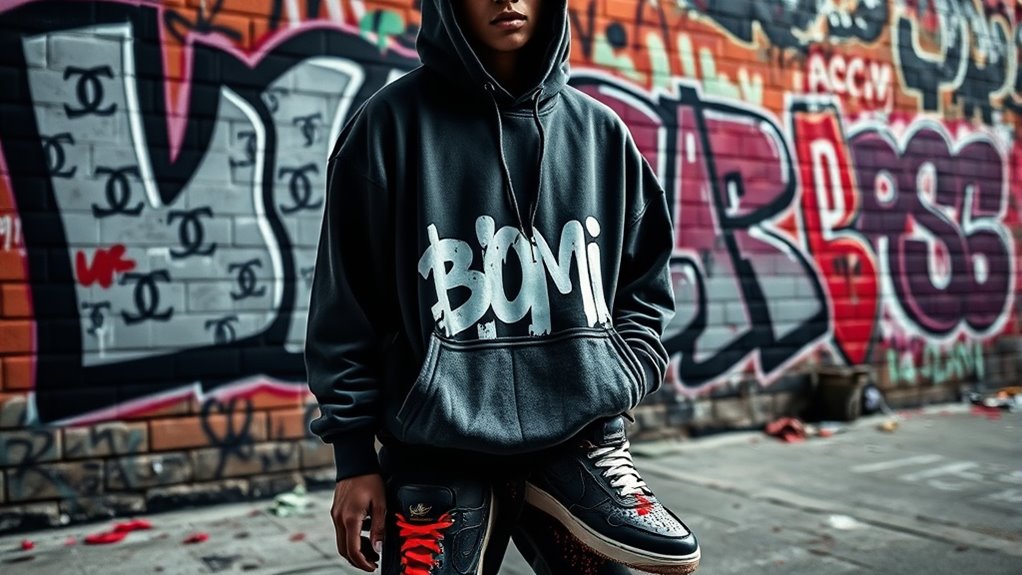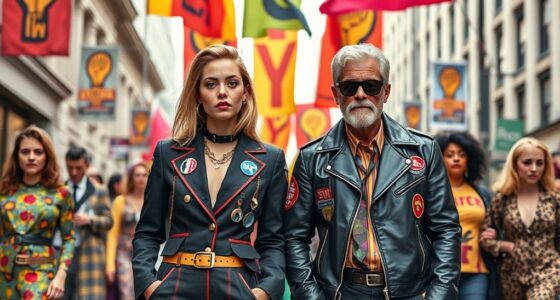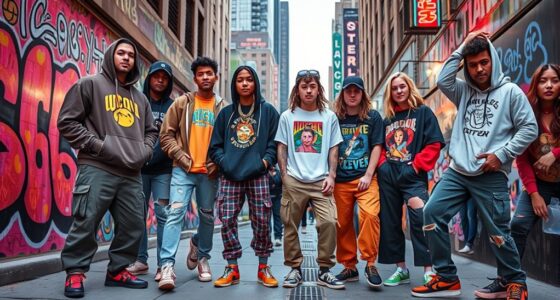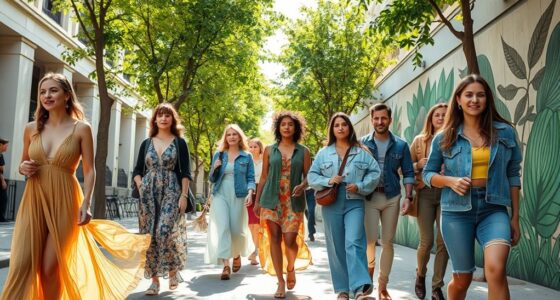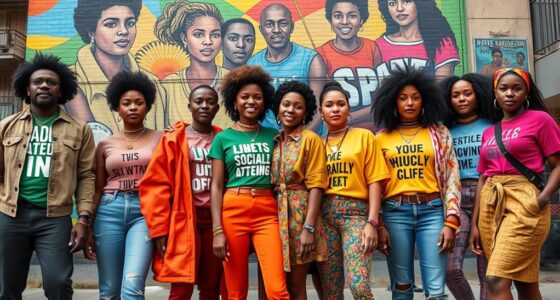Luxury brands are increasingly borrowing from street culture, blending rebellious urban styles with high-end fashion to create bold, authentic statements. This shift signals a move toward more relatable and culturally resonant designs that appeal to diverse audiences. Collaborations with streetwear brands and incorporating graffiti-inspired art or sneaker influences help elevate street aesthetics into luxury. To understand how this fusion reshapes brand identity and sparks controversy, you’ll find more insights ahead.
Key Takeaways
- Luxury brands incorporate street-inspired elements like graffiti, sneakers, and bold graphics to create edgy, culturally resonant collections.
- Collaborations with streetwear icons and limited editions generate hype, blurring the lines between high fashion and urban culture.
- Street culture’s authenticity boosts brand relatability, but raises concerns about cultural appropriation and superficiality.
- Integration of digital tech, such as augmented reality, enhances storytelling and consumer engagement in street-luxe collaborations.
- Ethical considerations include respecting marginalized communities and promoting sustainable, responsible practices within street-influenced luxury fashion.
The Evolution of Streetwear’s Influence on Luxury Fashion
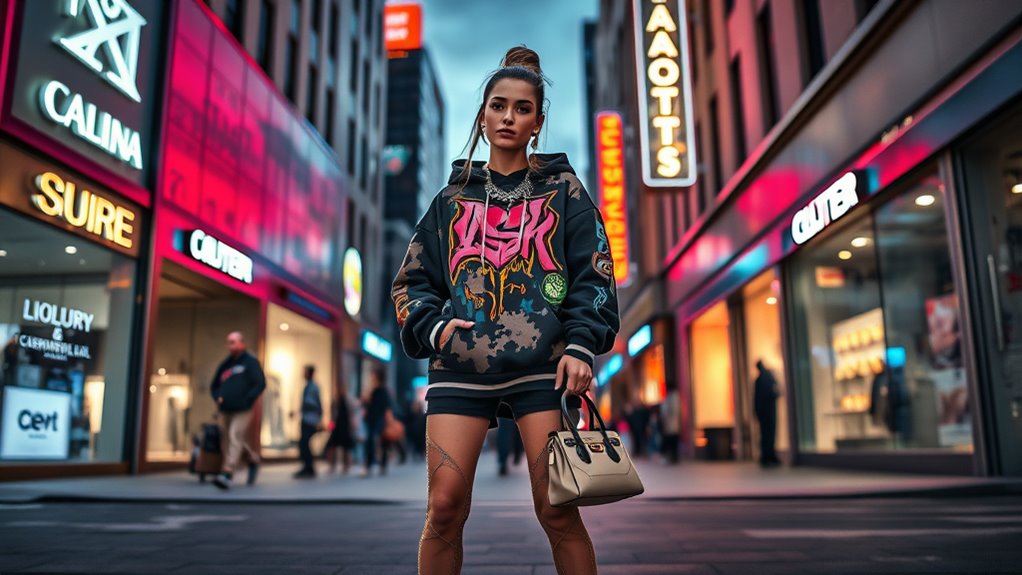
Streetwear’s rise has markedly reshaped the landscape of luxury fashion, blurring the lines between casual and high-end style. You can see this clearly in sneaker culture, where limited-edition collaborations and innovative designs have elevated sneakers from everyday footwear to coveted luxury items. Skateboard branding also plays a role, as logos and graphics from skateboard culture now adorn high-end apparel, making street-inspired aesthetics mainstream. Luxury brands have embraced this shift, incorporating bold, casual elements into their collections to attract a younger, more diverse audience. This evolution signifies a shift where streetwear isn’t just a trend but a foundational influence on contemporary luxury fashion, pushing designers to rethink material choices, branding, and the overall approach to high-end style. Additionally, the integration of Italian food culture, slow travel, and creative technology demonstrates how fashion continually adapts by blending diverse cultural elements into modern luxury aesthetics. The acceptance of streetwear-inspired designs by high fashion houses underscores the importance of cultural relevance and authenticity in today’s luxury market.
Iconic Collaborations Between High-End Brands and Streetwear Labels
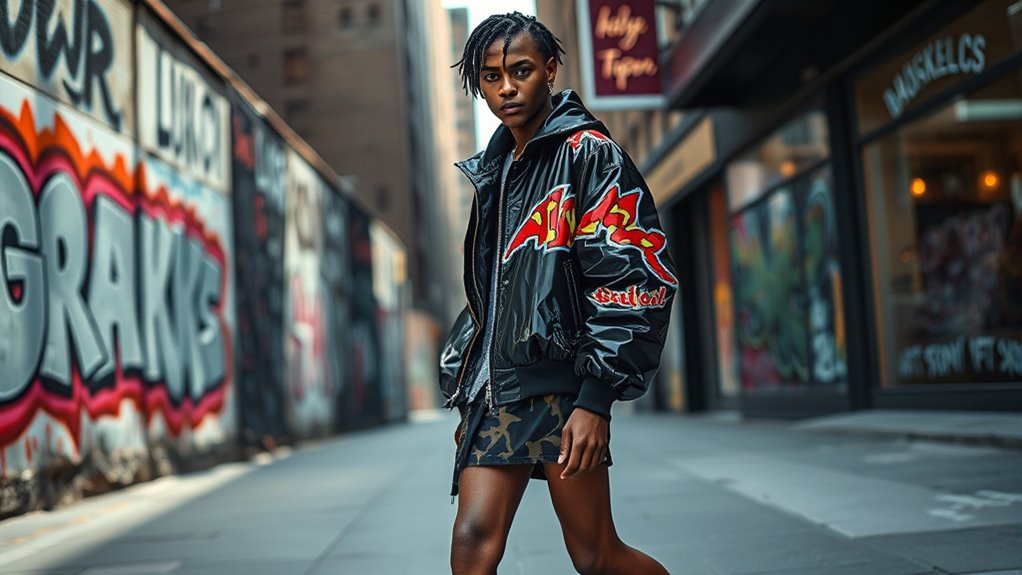
You’ve probably seen how limited edition drops and capsule collections create buzz around these collaborations. When high-end brands and streetwear labels combine aesthetics, they generate a fresh, cross-genre look that appeals to both worlds. This hype-driven approach keeps fans enthusiastic and drives exclusivity, making each release an event to remember. Incorporating variety of materials in designs can also enhance the appeal and durability of these collaborations. Moreover, integrating wall organization systems can showcase these collections in stylish home decor displays, elevating their visual impact. Additionally, blending cultural influences can deepen the connection between brands and diverse audiences, elevating the overall impact of the collections.
Iconic Capsule Launches
Iconic capsule launches have become the ultimate expression of collaboration, blending the worlds of high fashion and streetwear to create buzzworthy collections. These limited-edition drops often fuse sneaker culture with graffiti art influences, making them highly sought after. You see brands like Louis Vuitton teaming up with streetwear icons, integrating bold graphics and vibrant designs that echo urban art scenes. These capsules aren’t just about clothing; they’re about making a statement—merging luxury craftsmanship with street cred. When a high-end label releases a capsule inspired by graffiti art or sneaker aesthetics, it taps into youth culture’s pulse. The result? An instant cultural phenomenon that elevates streetwear’s status and redefines the boundaries of high fashion.
Cross-Brand Aesthetic Fusion
When high-end brands collaborate with streetwear labels, they create a dynamic fusion of aesthetics that pushes fashion boundaries. This cross-brand aesthetic fusion blends luxury craftsmanship with raw street elements like sneaker culture and graffiti art, making statements that resonate globally. You’ll see:
- Iconic sneakers that combine luxury materials with graffiti-inspired designs, appealing to sneaker culture enthusiasts. These designs often incorporate vibrational energy, reflecting the rebellious and expressive spirit of street culture. Integrating essential oils for street culture into design narratives can enhance the sensory experience of these collaborations.
- Apparel featuring bold graffiti motifs, elevating street art into high fashion statements.
- Limited-edition collaborations that challenge traditional boundaries, blending street grit with sophisticated style.
These collaborations blur lines, creating a fresh visual language that attracts a diverse audience. By merging street art’s rebellious spirit with luxury’s refinement, brands redefine what’s possible in fashion and set new trends that are both edgy and exclusive. Additionally, these partnerships often foster personal growth by encouraging consumers to explore new styles and identities beyond conventional fashion norms.
Limited Edition Hype
Limited edition collaborations between high-end brands and streetwear labels generate intense hype by blending exclusivity with street credibility. These drops tap into sneaker culture and graffiti art, making them highly sought after. Limited availability fuels demand, creating buzz among collectors and fans alike. You’ll notice brands often release these products with bold designs that honor street art origins or sneakers’ rebellious spirit. A new sentence with cultural relevance and the rest of the sentence. The table below highlights key aspects:
| Aspect | Impact |
|---|---|
| Exclusivity | Drives desire and perceived value |
| Street Credibility | Boosts authenticity and cultural relevance |
| Limited Runs | Ensures scarcity and hype |
This synergy amplifies the appeal, making each release a cultural event that fans eagerly chase. Brand collaborations further elevate these drops by combining fashion innovation with street culture heritage. Additionally, the limited edition aspect encourages consumers to act quickly, heightening anticipation and excitement around each launch.
Key Trends and Aesthetics Borrowed From Urban Culture
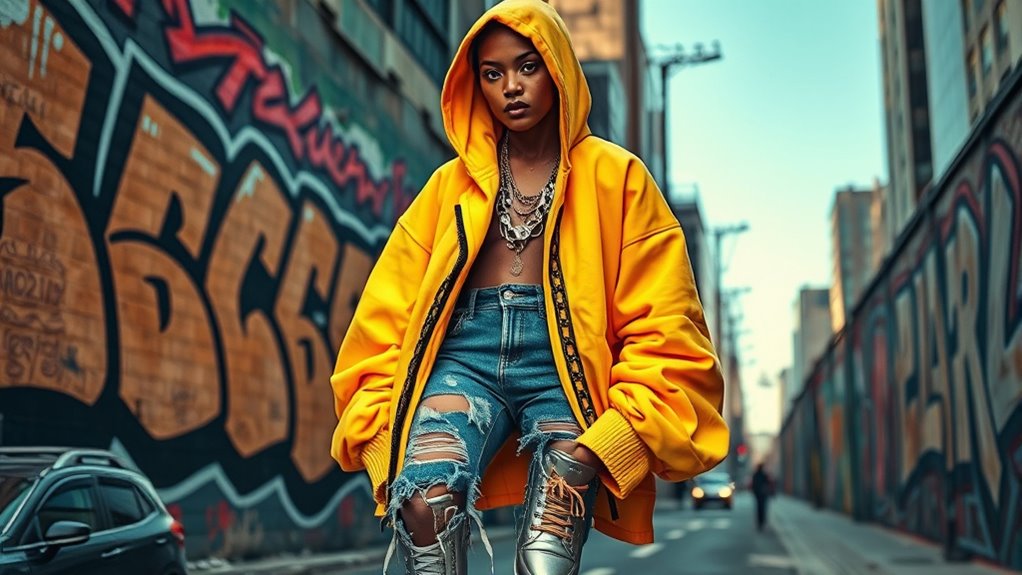
Urban culture has profoundly influenced high fashion by introducing bold trends and distinctive aesthetics that challenge traditional elegance. You can see this influence in key trends and aesthetics that brands now incorporate.
- Graffiti art inspires vibrant prints and edgy designs, making clothing look more rebellious and expressive.
- The sportswear influence leads to oversized silhouettes, technical fabrics, and athletic details, blending comfort with luxury.
- Bold branding and logo-centric styles draw from streetwear’s emphasis on visibility and identity.
- Additionally, incorporating elements of lifestyle trends helps brands stay relevant and appeal to the evolving tastes of a younger, diverse audience.
- This fusion often leverages digital culture to engage consumers in innovative ways and enhance brand storytelling across platforms.
This fusion of styles encourages innovation and often results in collaborations that push the boundaries of conventional fashion.
These elements push the boundaries of traditional fashion, creating a fresh, dynamic look rooted in urban expression. By borrowing from street culture, high fashion gains a raw, authentic edge that appeals to a younger, diverse audience.
The Impact on Brand Identity and Consumer Perceptions

The infusion of urban culture into high fashion considerably reshapes brand identity and consumer perceptions by signaling boldness, authenticity, and a willingness to challenge traditional norms. When luxury brands incorporate street-inspired elements, they often appear more relatable and genuine, strengthening their brand authenticity. This shift appeals to consumers seeking brands that reflect their values and cultural identity, fostering deeper emotional connections. As a result, your perception of these brands becomes more positive, aligning them with modern, diverse, and progressive ideals. This authenticity can boost consumer loyalty, encouraging repeat purchases and advocacy. Additionally, integrating street culture requires genuine engagement and understanding to avoid superficial adoption that could lead to cultural misappropriation. Recognizing the importance of cultural sensitivity is essential for brands aiming to authentically embrace street culture without alienating their audience. However, it also requires brands to genuinely embrace street culture, or risk appearing inauthentic, which could damage trust and long-term reputation. Ultimately, authentic integration enhances brand relevance in a rapidly evolving fashion landscape. Implementing AI-powered content clusters can help brands develop more targeted and relevant messaging that resonates with contemporary audiences.
Controversies and Criticisms Surrounding the Trend
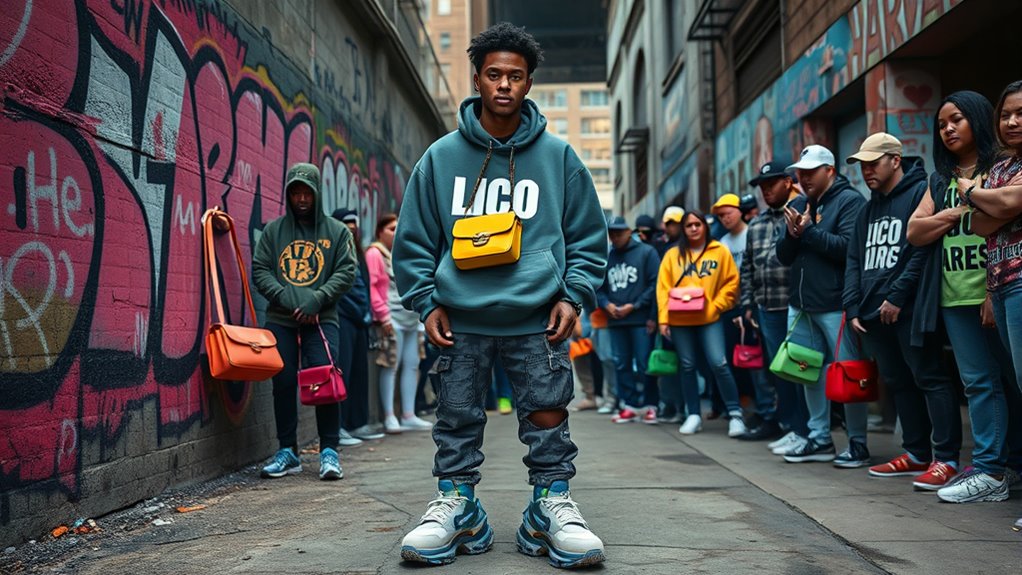
While the integration of street culture into high fashion has attracted praise for its boldness and innovation, it has also sparked significant controversy. You might encounter debates over cultural appropriation, where brands are accused of taking elements from marginalized communities without proper respect or acknowledgment. Additionally, exclusivity debates arise, questioning whether luxury brands commodify street styles to sell limited-edition items at exorbitant prices, diluting their original meaning. Moreover, concerns about secure payment processing and transparent transaction fees are crucial for consumers and businesses engaging in these evolving fashion markets, as merchant services ensure seamless and trustworthy financial exchanges. The rise of remote hackathons in the tech industry reflects a similar trend of collaboration and innovation across boundaries, which can be harnessed for ethical brand development and community engagement. These controversies highlight the complex ethics behind this fashion fusion and underscore the importance of cybersecurity in protecting both consumers and brands from digital threats.
Future Directions: The Continuing Fusion of High and Street Fashion
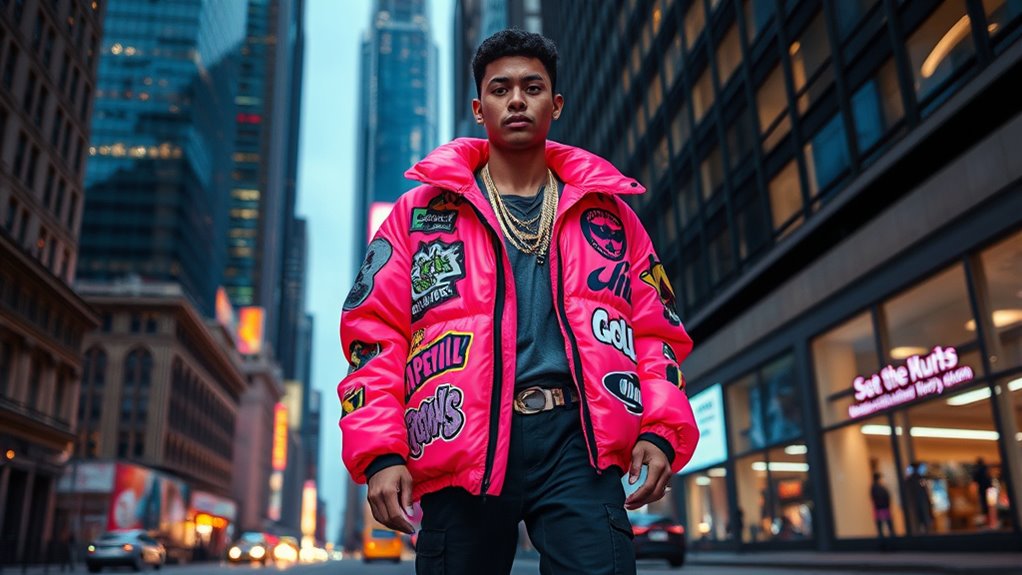
As designers and consumers continue to blur the lines between high fashion and streetwear, the fusion is likely to evolve into more innovative and nuanced expressions. You’ll see brands prioritize sustainable innovation, integrating eco-friendly materials and ethical practices into their designs. Digital integration will also play a key role, transforming how you experience and engage with fashion through virtual try-ons, augmented reality, and online collaborations. This ongoing fusion encourages a more inclusive, accessible, and dynamic fashion landscape, where boundaries are constantly challenged and redefined. As technology advances and sustainability becomes central, expect this blending to foster fresh creative expressions that appeal to diverse audiences. Furthermore, the integration of sustainable innovation in fashion design ensures that future collaborations will not only push creative boundaries but also promote environmental responsibility and social consciousness. The increasing emphasis on eco-friendly materials will be crucial in shaping more responsible and forward-thinking collections. Additionally, collaborations between luxury and streetwear brands are increasingly emphasizing authenticity, resonating with a broader consumer base. Ultimately, the future of high and street fashion lies in seamless collaboration, driven by innovation and a shared desire for authenticity.
Frequently Asked Questions
How Do Luxury Brands Choose Which Street Elements to Incorporate?
When luxury brands decide which street elements to incorporate, you notice they focus on cultural symbolism and design innovation. They seek elements that resonate with urban identities, making sure the symbols connect emotionally with their audience. They also look for fresh, innovative designs that can elevate street culture into high fashion. By carefully selecting these elements, they create a blend of authenticity and luxury that appeals to both worlds.
What Are the Legal Implications of Borrowing Street Culture Aesthetics?
Think of borrowing street culture aesthetics like walking a tightrope—you need balance to avoid falling into legal trouble. When you incorporate elements, you risk copyright infringement or trademark disputes if the designs are protected. Luxury brands must be careful, ensuring they don’t copy too closely, or they could face lawsuits. Staying original and respectful helps avoid legal issues, keeping your creative fusion both stylish and legally sound.
How Do Consumers Differentiate Authentic Collaborations From Imitations?
You can tell authentic collaborations from imitations by paying attention to brand authenticity and consumer perception. Genuine partnerships often feature transparent communication, consistent branding, and respect for street culture, which resonate with your values. When you see a collaboration that feels sincere, well-crafted, and aligns with the brand’s history, you’re more likely to perceive it as authentic. Conversely, imitations may seem superficial or rushed, making it easier to spot the difference.
What Role Does Social Media Play in Popularizing High Fashion Street Style?
You might not realize it, but social media drives over 70% of viral trends, shaping how you see high fashion street style. Influencers have a huge impact, showcasing streetwear as luxury and making these looks mainstream. Platforms like Instagram and TikTok turn everyday styles into global phenomena overnight, encouraging you to adopt and personalize high fashion street style. Social media fundamentally connects you to a dynamic, ever-evolving fashion landscape.
Can This Fusion of Fashion Genres Sustain Long-Term Brand Loyalty?
You might wonder if blending fashion genres can keep long-term brand loyalty. It’s possible if you focus on maintaining a strong brand identity that resonates with your audience. When consumers perceive authenticity and innovation, they stay loyal. By balancing street culture influences with your core values, you create a dynamic image that attracts new followers while retaining existing ones, ensuring your brand remains relevant and trusted over time.
Conclusion
As the runway and street collide like a powerful wave, this fusion reshapes fashion’s landscape. You’re now part of a dynamic dance where luxury and urban culture spin together, creating a vibrant tapestry of style. Embrace the boldness, but stay mindful of the shadows behind the trend. Like a river carving new paths, this high-low blend keeps evolving—an unstoppable force that transforms how you see and wear fashion every day.
